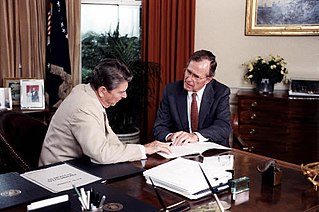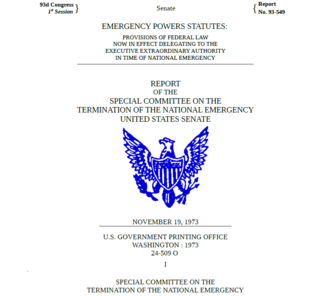
The Alien and Sedition Acts were a set of four laws enacted in 1798 that applied restrictions to immigration and speech in the United States. The Naturalization Act increased the requirements to seek citizenship, the Alien Friends Act allowed the president to imprison and deport non-citizens, the Alien Enemies Act gave the president additional powers to detain non-citizens during times of war, and the Sedition Act criminalized false and malicious statements about the federal government. The Alien Friends Act and the Sedition Act expired after a set number of years, and the Naturalization Act was repealed in 1802. The Alien Enemies Act is still in effect.

The president of the United States (POTUS) is the head of state and head of government of the United States of America. The president directs the executive branch of the federal government and is the commander-in-chief of the United States Armed Forces.
In the United States government, independent agencies are agencies that exist outside the federal executive departments and the Executive Office of the President. In a narrower sense, the term refers only to those independent agencies that, while considered part of the executive branch, have regulatory or rulemaking authority and are insulated from presidential control, usually because the president's power to dismiss the agency head or a member is limited.

The federal government of the United States is the national government of the United States, a federal republic located primarily in North America, composed of 50 states, five major self-governing territories, several island possessions, and the federal district and national capital of Washington, D.C., where most of the federal government is based.

A decree is a legal proclamation, usually issued by a head of state such as the president of a republic, or a monarch, according to certain procedures. It has the force of law. The particular term used for this concept may vary from country to country. The executive orders made by the President of the United States, for example, are decrees.

Separation of powers is a political doctrine originating in the writings of Charles de Secondat, Baron de Montesquieu in The Spirit of the Laws, in which he argued for a constitutional government with three separate branches, each of which would have defined abilities to check the powers of the others. This philosophy heavily influenced the drafting of the United States Constitution, according to which the Legislative, Executive, and Judicial branches of the United States government are kept distinct in order to prevent abuse of power. The American form of separation of powers is associated with a system of checks and balances.
United States v. Curtiss-Wright Export Corp., 299 U.S. 304 (1936), was a decision of the United States Supreme Court concerning the foreign affairs powers of the president of the United States. It held that the President, as the nation's "sole organ" in international relations, was therefore innately vested with significant powers over foreign affairs, far exceeding those permitted in domestic matters or accorded to the U.S. Congress. The Court's majority reasoned that although the U.S. Constitution does not explicitly provide for such authority, the powers are implicit in the President's constitutional role as commander-in-chief and head of the executive branch.
Youngstown Sheet & Tube Co. v. Sawyer, 343 U.S. 579 (1952), also commonly referred to as the Steel Seizure Case or the Youngstown Steel case, was a landmark United States Supreme Court decision that limited the power of the President of the United States to seize private property. The case served as a check on the most far-reaching claims of executive power at the time and signaled the Court's increased willingness to intervene in political questions.
The powers of the president of the United States include those explicitly granted by Article II of the United States Constitution as well as those granted by Acts of Congress, implied powers, and also a great deal of soft power that is attached to the presidency.
The unitary executive theory is a legal theory in United States constitutional law which holds that the President of the United States possesses the power to control the entire federal executive branch. The doctrine is rooted in Article Two of the United States Constitution, which vests "the executive Power" of the United States in the President.

A signing statement is a written pronouncement issued by the President of the United States upon the signing of a bill into law. They are usually printed in the Federal Register's Compilation of Presidential Documents and the United States Code Congressional and Administrative News (USCCAN). The statements offer the president's view of the law or laws created by the bill.

The National Emergencies Act (NEA) is a United States federal law passed to end all previous national emergencies and to formalize the emergency powers of the President.

The Report of the Special Committee on the Termination of the National Emergency, also known as Senate Report 93-549, was a document issued by the "Special Committee on the Termination of the National Emergency" of the 93rd Congress. Its purpose was to discuss and address the 40-year-long national emergency that had been in effect in the United States since 1933. During the continued emergency, Congress voted to transfer powers from itself to the President. The debate to end long-running national emergencies ended in 1976 with the National Emergencies Act, which rescinded the president's authority under the prior emergencies and established an expiration period on future declared emergencies.
A presidential memorandum is a type of directive issued by the president of the United States to manage and govern the actions, practices, and policies of the various departments and agencies found under the executive branch of the United States government. It has the force of law and is usually used to delegate tasks, direct specific government agencies to do something, or to start a regulatory process. There are three types of presidential memoranda: presidential determination or presidential finding, memorandum of disapproval, and hortatory memorandum.

The Administrative Procedure Act (APA), Pub. L.Tooltip Public Law 79–404, 60 Stat. 237, enacted June 11, 1946, is the United States federal statute that governs the way in which administrative agencies of the federal government of the United States may propose and establish regulations, and it grants U.S. federal courts oversight over all agency actions. According to Hickman & Pierce, it is one of the most important pieces of United States administrative law, and serves as a sort of "constitution" for U.S. administrative law.
Primary legislation and secondary legislation are two forms of law, created respectively by the legislative and executive branches of governments in representative democracies. Primary legislation generally consists of statutes, also known as 'acts', that set out broad principles and rules, but may delegate specific authority to an executive branch to make more specific laws under the aegis of the principal act. The executive branch can then issue secondary legislation, creating legally enforceable regulations and the procedures for implementing them.
Presidential reorganization authority is a term used to refer to a major statutory power that has sometimes been temporarily extended by the United States Congress to the President of the United States. It permits the president to divide, consolidate, abolish, or create agencies of the U.S. federal government by presidential directive, subject to limited legislative oversight. First granted in 1932, presidential reorganization authority has been extended to nine presidents on 16 separate occasions. As of 2017, it was most recently granted to Ronald Reagan.
A presidential directive, or executive action, is a written or oral instruction or declaration issued by the president of the United States, which may draw upon the powers vested in the president by the U.S. Constitution, statutory law, or, in certain cases, congressional and judicial acquiescence. Such directives, which have been issued since the earliest days of the federal government, have become known by various names, and some have prescribed forms and purposes. Presidential directives remain in effect until they are revoked, which the president is free to do. The classification of presidential directives is not easily done, as the distinction between the types can be quite arbitrary, arising from convenience and bureaucratic evolution, and none are defined in the Constitution. Furthermore, the different types may overlap. As one legal scholar put it: "it is a bit misleading to overclassify presidential directives as comprising separate and distinct 'types' just because they have different headings at the top of the first page." In terms of legal applicability, what matters is the substance of the directive, not the form, unless a certain kind of directive is specifically required by relevant statute.

Donald Trump signed a total of 570 proclamations from January 2017 to January 2021.










